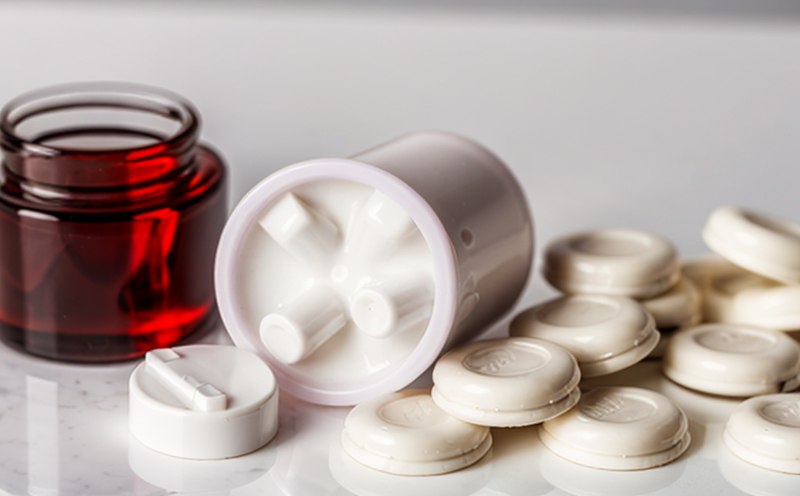Residual Solvents by GC Headspace Test
The Residual Solvents by GC (Gas Chromatography) Headspace Test is a critical analytical procedure used in the pharmaceutical sector to ensure product quality and safety. This test method detects volatile organic compounds that may remain after extraction or processing of oral solid dosage forms such as tablets, capsules, and powders.
This testing ensures compliance with regulatory standards like USP 1, EU guidelines, and ICH Q3C(R7) 2. Residual solvents can be hazardous if present in high concentrations. They may affect the stability of active pharmaceutical ingredients (APIs), lead to formulation issues, or cause health risks upon consumption.
The GC Headspace Test involves isolating volatile compounds from a sealed container containing the sample without direct contact between the liquid solvent and the analytical column. This prevents any interference in the chromatographic separation process. The method is highly sensitive and selective, capable of detecting trace amounts of solvents down to parts per million (ppm).
Preparation for this test includes thorough sampling of the oral solid dosage forms. Samples are sealed within a vial with an appropriate headspace gas such as nitrogen or helium to maintain pressure during analysis. The sample is then introduced into the GC system, where it undergoes thermal desorption. This process allows volatiles to be released and carried by the carrier gas through the column.
The separation of compounds in this test depends on their physical properties like boiling points, polarity, and volatility. Once separated, the analytes are detected using a mass selective detector or flame ionization detector. Identification is made based on retention time compared with known standards.
Compliance with regulatory requirements ensures that pharmaceutical products meet safety and efficacy standards before reaching consumers. This testing plays an essential role in quality control processes by providing reliable data on residual solvent levels. The results help manufacturers make informed decisions about raw material selection, processing conditions, and overall product formulation.
The GC Headspace Test is widely used across various industries beyond just pharmaceuticals but particularly relevant for sectors involving chemical synthesis or extraction. In the pharmaceutical industry specifically, it serves as a key tool in ensuring drug purity and safety during production.
- Regulatory Compliance: Ensures adherence to USP, EU, ICH guidelines.
- Purity Assurance: Detects trace amounts of residual solvents.
- Safety: Prevents potential health risks associated with high levels of volatile organic compounds in medications.
- Quality Control: Provides reliable data on the quality and safety of medicinal products.
The importance of this testing cannot be overstated, especially given increasing public awareness regarding product safety. By employing rigorous testing protocols like GC Headspace analysis, pharmaceutical companies can maintain their reputation for producing safe and effective medicines.
Scope and Methodology
The scope of the Residual Solvents by GC Headspace Test encompasses various aspects related to the identification, quantification, and regulation of volatile organic compounds present in oral solid dosage forms. This section outlines the detailed methodology employed during this testing process.
The procedure begins with sampling the product directly from its packaging or container. It is crucial that samples are representative of the entire batch being tested to ensure accurate results. After collection, samples are placed into sealed vials along with an inert gas like nitrogen or helium to prevent contamination and maintain pressure during analysis.
Once properly prepared, these sealed vials containing the sample enter the GC system where they undergo thermal desorption. This step releases volatile compounds from their matrix onto a solid adsorbent which then transfers them into the carrier gas stream for transportation through the column. The temperature profile within this oven ensures optimal release of all relevant compounds without causing decomposition.
As mentioned earlier, after separation occurs in the column based on differences in boiling points and other physical characteristics, each component passes through a detector capable of identifying it via its unique retention time relative to known standards. Identification typically relies upon mass spectral data generated by mass selective detectors which provide detailed information about molecular structures.
The results obtained from this analysis are reported according to specified formats defined by relevant regulatory bodies. These reports include quantitative values for each detected solvent along with qualitative descriptions of any unknown peaks observed during the run. Interpretation of these findings helps determine whether a batch meets established limits set forth in official compendia or other applicable guidelines.
It is important to note that while this description provides an overview, actual procedures may vary slightly depending on specific laboratory practices and equipment used. However, adherence to standardized methods ensures consistency across different facilities conducting similar tests.
Competitive Advantage and Market Impact
The ability to perform accurate residual solvents testing on oral solid dosage forms provides significant competitive advantages in the pharmaceutical industry. By ensuring product purity and safety, companies can build trust with consumers and healthcare providers alike.
Compliance with regulatory standards like USP, EU guidelines, and ICH Q3C(R7) not only demonstrates a commitment to quality but also helps protect against potential recalls or legal challenges. This reduces the risk of costly mistakes while enhancing brand reputation.
In addition to meeting these external requirements, internal use of this testing ensures consistency across different batches and facilities. Consistent results enable companies to refine their manufacturing processes continuously, leading to improved product quality over time.
The market impact of reliable residual solvents testing extends beyond individual firms; it contributes positively towards overall industry standards by promoting best practices in drug development and production. As awareness grows about the importance of these tests, more competitors are likely to adopt similar approaches, creating a virtuous cycle that benefits all participants involved.





